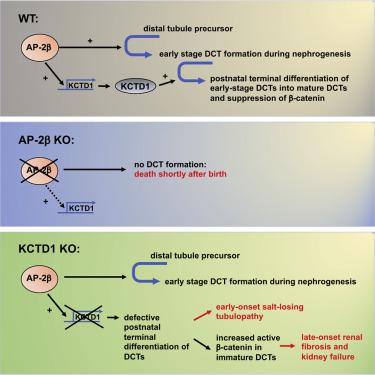Developmental Cell ( IF 10.7 ) Pub Date : 2020-06-17 , DOI: 10.1016/j.devcel.2020.05.026 Alexander G Marneros 1

|
The developmental mechanisms that orchestrate differentiation of specific nephron segments are incompletely understood, and the factors that maintain their terminal differentiation after nephrogenesis remain largely unknown. Here, the transcription factor AP-2β is shown to be required for the differentiation of distal tubule precursors into early stage distal convoluted tubules (DCTs) during nephrogenesis. In contrast, its downstream target KCTD1 is essential for terminal differentiation of early stage DCTs into mature DCTs, and impairment of their terminal differentiation owing to lack of KCTD1 leads to a severe salt-losing tubulopathy. Moreover, sustained KCTD1 activity in the adult maintains mature DCTs in this terminally differentiated state and prevents renal fibrosis by repressing β-catenin activity, whereas KCTD1 deficiency leads to severe renal fibrosis. Thus, the AP-2β/KCTD1 axis links a developmental pathway in the nephron to the induction and maintenance of terminal differentiation of DCTs that actively prevents their de-differentiation in the adult and protects against renal fibrosis.
中文翻译:

AP-2β/KCTD1 控制远端肾单位分化并防止肾纤维化。
协调特定肾单位节段分化的发育机制尚不完全清楚,在肾发生后维持其终末分化的因素在很大程度上仍然未知。在这里,转录因子 AP-2β 被证明是肾形成过程中远端小管前体分化为早期远曲小管 (DCT) 所必需的。相反,其下游靶标 KCTD1 对于早期 DCTs 终末分化为成熟 DCTs 是必不可少的,由于缺乏 KCTD1,它们的终末分化受损导致严重的失盐性肾小管病。此外,成人持续的 KCTD1 活性使成熟的 DCT 保持在这种终末分化状态,并通过抑制 β-连环蛋白的活性来预防肾纤维化,而 KCTD1 缺乏会导致严重的肾纤维化。因此,AP-2β/KCTD1 轴将肾单位中的一条发育途径与 DCT 终末分化的诱导和维持联系起来,从而积极防止它们在成人中去分化并防止肾纤维化。











































 京公网安备 11010802027423号
京公网安备 11010802027423号